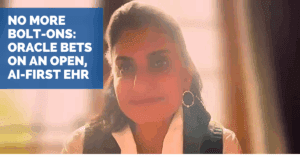Health IT leaders know the script: every new release promises fewer clicks, smoother workflows, and real relief for clinicians. Too often, the reality is another layer of complexity on systems already past their prime. Did Oracle buck that trend with their new EHR?
Seema Verma, Executive Vice President and General Manager for Oracle Health and Life Sciences, sat down with Healthcare IT Today to discuss the company’s complete rebuild of its EHR. She pointed to the technology foundations, the openness of the platform, and the usability gains that separate it from what she calls “the old playbook.”
Key Takeaways
- Built for AI, not retrofitted. Oracle rebuilt its EHR on a semantic index, rejecting legacy databases that were never designed to handle modern AI workloads.
- An open ecosystem, not a walled garden. Providers can create, share, and monetize their own AI agents without giving up IP – Oracle’s platform is designed to encourage outside innovation.
- Consumer-grade usability. In beta tests, physicians needed no training – logging in and using the system immediately, with an interface designed to match modern consumer tech.
Built for AI, not retrofitted
Instead of layering AI on top of outdated databases, Oracle rebuilt its new EHR on a semantic index designed for machine learning. Verma drew a sharp line against competitors still reliant on decades-old infrastructure: “Our competitors are using very old technology. They’re using 1990s databases, and those are not built for AI. If you want to reduce burden on providers, bring in data from multiple sources, and actually make AI useful in healthcare, you can’t do that on old technology. That’s why we made the decision to start fresh with a semantic index.”
An open ecosystem, not a walled garden
Verma also underscored a deliberate move away from closed systems. “We’re not bolting on AI solutions. We built a platform where AI agents are embedded in the EHR itself,” she explained. “What’s different is that customers can also build their own agents, share them with others, and they continue to own the IP. Oracle doesn’t take it. If a provider develops something innovative—say, a protocol for diabetes management—they could use it across their system, share it with peers, or even monetize it.” For an industry where interoperability has too often meant vendor lock-in, the prospect of an open, shared ecosystem represents a welcome shift away from the typical walled garden approach.
Consumer-grade usability
Perhaps the most striking detail was the feedback from Oracle’s beta sites. “The doctors came in, sat down, and started using it without any training,” Verma recalled. “They were able to just get on and it looked like the modern technology we’re all using in other parts of our lives.”
This is opposite of what many clinicians have come to expect from EHR rollouts.
This new UI is a preview of what may be ahead. Oracle plans to extend the same usability philosophy to its clinical trials suite which aims to close the gap between research and care delivery by making those processes part of the same intuitive experience.
Beyond Bolt-Ons
Oracle is sending a clear message to the healthcare market: the era of layering fixes on top of legacy systems has run its course. By rebuilding its EHR for AI from the ground up, the company is signaling a different playbook. It remains to be seen if the reception to their new EHR a year from now will be as warm as it is today, but it is encouraging to hear that right now a doctor can sit down, click once, and get right to work.
Learn more about Oracle’s new EHR: https://www.oracle.com/news/announcement/oracle-unveils-next-generation-ehr-2024-10-29/
Learn more about Oracle Health: https://www.oracle.com/health/
Listen and subscribe to the Healthcare IT Today Interviews Podcast to hear all the latest insights from experts in healthcare IT.
And for an exclusive look at our top stories, subscribe to our newsletter and YouTube.
Tell us what you think. Contact us here or on Twitter at @hcitoday. And if you’re interested in advertising with us, check out our various advertising packages and request our Media Kit.




